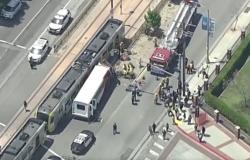Satellite images verified by FRANCE 24 reveal that China has built a replica of Taipei’s presidential district in remote Inner Mongolia, fueling speculation that Beijing intends to use the site as a training ground to prepare for a future invasion of Taiwan.
The satellite images show a detailed replica of the heart of Taipei – despite surrounded by the arid landscape of Inner Mongolia instead of Taiwan’s lush vegetation.
https://twitter.com/JosephWen___/status/1772446247795708023 on social media by a Taiwanese data analyst, on March 26, they were later picked up by the website Taiwan News, under the ominous headline: “China creates Taipei mockup to train for invasion”.
FRANCE 24 was able to verify the existence of the mockup, located some 1,200 kilometers west of Beijing.
Sim Tack, an analyst at intelligence firm Force Analysis, which monitors conflict zones and has access to satellite imagery, said construction of the replica began in March 2021 and lasted approximately one year.
He said the site features buildings and facades “that are inspired by what you can see in Taipei, without having exactly the same size or shape”.
An area of interest
The satellite images reveal a layout of streets strongly resembling the Bo’ai Special Zone, a restricted area in Taipei’s Zhongzheng District that houses Taiwan’s most important state buildings, including the presidential palace, the supreme court, the ministry of justice and the central bank of Taiwan.
The Bo’ai Special Zone is subject to specific regulations, including a strict ban on overflight.
When quizzed about the images last week, Taiwan’s Defense Minister Chiu Juo-cheng appeared to play down their significance.
“It is inevitable that the Chinese army produces this type of imitation,” he told reporters, adding that Taiwan was also capable of replicating foreign sites for military training purposes.
The minister’s response was surprisingly measured, “considering that in recent months we have seen China multiply its hostile acts towards Taiwan”, noted Marc Lanteigne, a China expert at Norway’s Arctic University.
Beijing considers Taiwan a part of its territory and has not ruled out the use of force to assert control over the island. Under President Xi Jinping, it has stepped up its pressure on the self-governing island, mounting a series of incursions by fighter jets into Taiwan’s airspace in autumn 2023.
The existence of a training site to rehearse a potential attack on the presidential palace in Taipei is a stark reminder of the geopolitical tensions in the region, and of the threat weighing on Taiwan.
Propaganda tool
Experts note that Taiwan has faced this type of intimidation before, most notably in 2015, when the Chinese military produced an almost exact replica of the presidential palace in Taipei, at a separate site in Inner Mongolia.
At the time, Beijing chose to showcase the mockup, said Lewis Eves, a Chinese security expert at the University of Sheffield.
“We found this out because the video of a simulated assault on the building was broadcast on Chinese television and the army website published images of a training exercise in the grounds around the palace,” he explained.
Eves said he was not surprised to see the Chinese army produce a similar replica almost a decade later, pointing to “similarities between the current geopolitical context in the region and the one that prevailed in 2015”.
Back then, Taiwan was gearing up for a high-stakes presidential context in 2016, just like the recent vote that took place in January of this year. Tensions between China and regional rival Japan over disputed islands in the South China Sea were also at a high in 2015 – much as they are today.
Now as then, “Beijing has deemed it necessary to stage a show of force aimed both at Taiwan and its own public opinion, in order to whip up nationalist sentiment,” said Eves.
At a time of heightened international tensions, China is “seeking to rally public opinion behind the CCP [Chinese Communist Party] by playing the nationalist card”, said the security expert. And restating its claim about Taiwan in the interests of Chinese “national unity” is part of this effort, he added.
‘Psychological warfare’
In addition to serving propaganda purposes, the construction of Taipei replicas allows Chinese authorities to wage a form of “psychological warfare”, said China expert Ho Ting (Bosco) Hung, a geopolitical analyst at The International Team for the Study of Security (ITSS) Verona.
“It’s clearly a way of telling Taiwan that if the island’s authorities refuse to bend to China’s demands, Beijing is preparing military options,” he explained.
Read more‘People don’t want to talk about war’: Taiwan civil defense battles invasion risk denial
Analysts say China is unlikely to go to such lengths merely to send a signal to Taiwan and its own population. Unlike in 2015, they note, the latest release of satellite images from Inner Mongolia is not Beijing’s own doing. In fact, the Chinese military has been considerably more discreet this time.
Back in 2015, the replica presidential palace was nestled in the heart of the Zhurihe training compound, described by Chinese officials as the “largest in Asia”. Satellite images of the facility even show a building that bears a striking resemblance to the Eiffel Tower in Paris.
The new constructions, on the other hand, are located several hundred kilometers away, in a region that is “probably less closely monitored by Western satellites than the Zhurihe base”, noted Lanteigne.
It is possible that “the Chinese authorities were waiting for the right time to go public about the new site, but were defeated to it,” he added.
And while the replica of the Bo’ai Special Zone “may indeed serve propaganda purposes”, Hung argued, the most likely explanation is that “its primary purpose is military”.
Invasion scenarios
The new Taipei mockup is far more detailed than the one produced in 2015, meaning it could be used for two distinct military scenarios, the first of which involves an aerial bombardment of the Bo’ai area – or what the Taiwan News website described as a “decapitation strike on Taipei”.
Such an operation would be extremely complex to mount given “the high quality of Taiwan’s air defenses”, Hung cautioned, though adding that “an aerial attack remains the most rapid option to invade the island”.
The other scenario involves a land invasion of the island, located roughly 100 miles (160 kilometers) off the coast of southeastern China.
“If it were only contemplating a bombardment of the area, China would probably not have gone through the trouble of replicating an entire neighborhood of Taipei,” argued Lanteigne. “Urban warfare is the hardest of all, so it’s only natural that Beijing should try to get ready for it.”
In this respect, Taiwan may not be the only target on Beijing’s mind.
“Xi Jinping is pushing to reform and modernize his army, and knowing how to fight in an urban environment is an essential aspect of training,” Lanteigne added. “It is possible the army has chosen to recreate Taipei’s presidential district because that is one likely setting where it may have to intervene.”
This article is a translation of the original in French.
Tags: Taipei replica remote Chinese province fans Taiwan invasion fears
-





